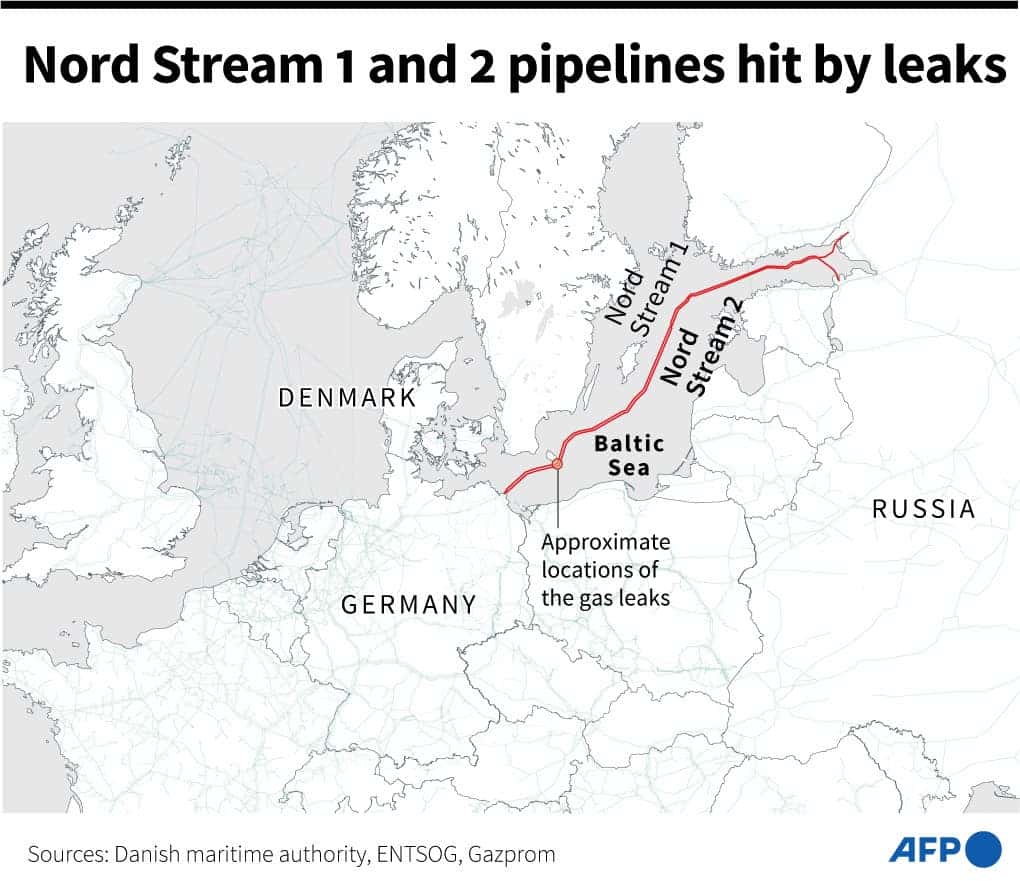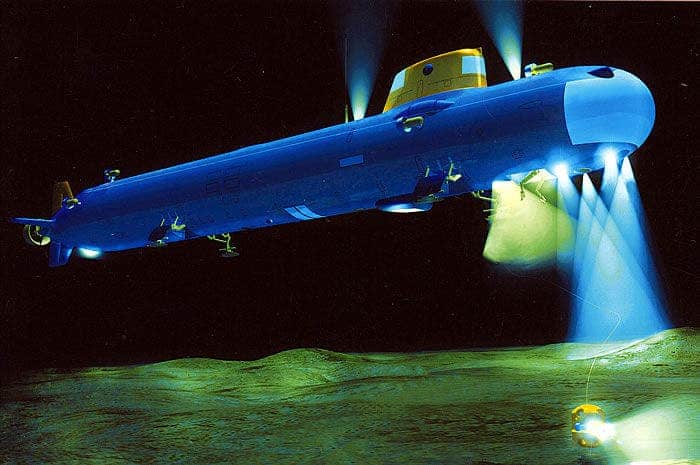Nord Stream 1 and 2, two huge pipelines under the Baltic Sea meant to pour huge quantities of natural gas from Russia to Germany, have each sprung leaks in mysterious conditions on Monday and Tuesday.
These leaks have formed a huge area of natural gas bubbles spanning one kilometer in diameter in the Baltic Sea. Another smaller area of gas bubbles measured about 200 meters.
European countries are now investigating the causes of these sudden and worrisome gas leaks, but all signs point to at least two explosions and sabotage is on everyone’s mind. But if it was really sabotaged, then who did it?
Gas leaks amidst a global energy crisis and war in Europe
On Monday, a seismograph on the Danish island of Bornholm recorded spikes in tremours consistent with explosions around the same time the Nordstream 1 and 2 underwent catastrophic loss of pressure. Not long after, Swedish and Danish authorities identified signs of natural gas bubbling to the water’s surface, hinting that the two major pipelines have sprung huge leaks. Although the two pipelines had stopped delivering fuel to Europe, they still contain a lot of gas under pressure, which has now leaked out.
Sweden’s Maritime Authority issued a warning about two leaks in the Nord Stream 1 pipeline shortly after a leak on the nearby Nord Stream 2 pipeline was discovered, prompting Denmark to restrict shipping within a five-nautical mile radius. That’s three locations where natural gas is massively leaking from, which sounds like a dubious coincidence.

Nord Stream 1, which is majority-owned by Russian state-owned Gazprom, is the single biggest pipeline bringing crucial supplies of Russian natural gas to Europe via Germany. Up to 55 billion cubic meters of gas used to flow through Nord Stream 1 every year. The Nord Stream 2 pipeline was completed in September 2021. It was supposed to double the flow of direct Russian gas to Germany — but it was never used following Russia’s invasion of Ukraine.
The implications of this could be severe.
The EU is heavily reliant on Russian gas. For instance, last year, Russia supplied some 40% of the EU’s natural gas. However, the war in Ukraine has unleashed an unprecedented energy crisis in the old continent that has seen prices of natural gas surge, in some cases by a factor of ten.
There’s a growing suspicion that Vladimir Putin’s Russia is using energy blackmail to punish European countries for their support of Ukraine and pressure them to call for peace as the freezing winter enters people’s homes. In Europe, some are already pointing to this as a deliberate act of sabotage.
In June, Russia cut flows through Nord Stream 1 to 40% of capacity, citing the delayed return of a turbine that was being serviced by Siemens Energy, an explanation that was immediately rejected by Germany and other European countries. Moscow then shut the pipeline altogether for 10 days of annual maintenance in July, restarting it on July 21 — still at 40% of normal levels.
At the end of August, Gazprom completely and indefinitely halted the flow of gas through Nord Stream 1. Gazprom yet again cited maintenance issues, a move that came just hours after G7 countries agreed on a price cap on Russian oil in order to disrupt cash flow to Vladimir Putin’s war chest. Meanwhile, Nordstream 2 has been suspended since February when Russia invaded Ukraine.
Deliberate sabotage?
All signs so far point to deliberate explosions rather than technical issues as an explanation for the leaks that have grown so big they can be seen on the radar of nearby vessels. These pipelines consist of more than 100,000 individual 24-tonne concrete-weighted steel pipes laid on the seabed, which can be incredibly sturdy. When pipes fail naturally, it’s usually due to things like corrosion or wear, but Nordstream 2 is a brand-new pipe.
“It’s hard to imagine that these are coincidences,” Mette Frederiksen, Denmark’s prime minister, told reporters Tuesday. “We can’t rule out sabotage.”
Meanwhile, Kremlin spokesman Dmitry Peskov said it was premature to speculate on sabotage before an official investigation is underway, although he added “Nothing can be ruled out.”
The timing of the leaks coincides with the inauguration of the Baltic Pipe on Tuesday. Baltic Pipe, a project initiated by Poland in 2016 following the Crimean War, long before Russia’s invasion of Ukraine in February this year, is a 900-kilometer pipeline that will soon transport natural gas from Norway via Denmark and through the Baltic Sea to Poland.
With an annual capacity of 10 billion cubic meters of gas, the pipeline “can bring gas from the fields on the Norwegian continental shelf and contribute to strengthening energy security in southern Scandinavia, Poland and other countries in the region,” Norwegian Minister of Petroleum and Energy Terje Aasland said on a Tuesday.
If Russia indeed sabotaged its own pipelines, it could have been to send a clear signal that something like this could happen to Baltic Pipe.
“The large-scale ‘gas leak’ from Nord Stream 1 is nothing more than a terrorist attack planned by Russia and an act of aggression towards the EU,” Kyiv’s Presidential advisor Mikhaylo Podolyak said on Twitter.
Did Russia really do it? If so, how?
Right now, Russia stands to benefit from the leakage of Nordstream. Although a lot of Russia’s gas revenue came from these pipelines, the Kremlin seems dead set on shutting them one way or another anyway because it sees the cost inflicted upon European countries to be much greater than the one it incurs. Basically, gas is its leverage against Europe.
By destroying its own pipelines, Gazprom can evade its contractual obligations by simply citing catastrophic malfunctions that could take months to repair or just as long as it takes to cause major disruption during the upcoming winter. Benchmark gas prices jumped as much as 12% on Tuesday, which again greatly benefits Russia.
To make matters even more suspicious, few would have had the capability to sabotage the pipes even if they wanted to — but Russia would be one such party. But if that’s the case, how did they do it? Investigations are underway and the truth is bound to surface eventually, but there are already some hypotheses.
The first obvious suspects are Russia’s spy submarines, which it inherited from the USSR. These submarines are equipped with special seabed engineering capabilities designed to sever critical enemy infrastructure in the event of war, including undersea communications cables, power cables, and energy pipelines.
Earlier this year, there have been concerns that such subs could sever global internet cables around the Irish shores. What’s more, one of two undersea fiber optic cables which provide vital internet connection and communications links between mainland Norway and the Svalbard archipelago in the Arctic Ocean was put out of action on January 7, and Russia was blamed for the downtime.

These submarines are operated by the Main Directorate of Deep-Sea Research, also known as GUGI and Military Unit 40056, within the Russian Ministry of Defense. GUGI is believed to field the world’s largest fleet of covert manned deep-sea vessels, consisting of eight highly specialized nuclear-powered submarines based in the Arctic. From these motherships, GUGI can launch a variety of autonomous underwater vehicles that are capable of torpedoing enemy undersea infrastructure.
Although GUGI is more than capable of targeting Nordstream, that seems rather unlikely. Perhaps a more likely possibility is the use of detonation devices placed by special forces divers that may be even harder to detect than supposedly stealthy but huge subs that displace a lot of mass.
The gas war
Gazprom is still pumping gas into Europe through another major pipeline it owns, a large portion of which passes through Ukraine, of all places. Gazprom said it will pipe 42.4 million cubic meters (cm) via Ukraine on Tuesday. Before the war, this pipeline delivered around 109 million cm. But today, Gazprom announced in a very roundabout way that it could shut down this gas supply as well.
On September 9, Ukraine’s state energy firm Naftogaz initiated a new arbitration proceeding against Gazprom, claiming the Russian energy giant has not paid the fees for gas transportation through Ukraine. In turn, Gazprom announced that since any arbitration would take place in Swedish and Swiss courts (two countries that have imposed sanctions against Russia and are thus deemed unfriendly and biased), the company is “deprived of its fundamental right to a fair and impartial hearing.” Gazprom adds that any further filing of appeal by Naftogaz will cause “the Russian state authorities to have every reason to introduce sanctions against Naftogaz of Ukraine.”
In practical terms, this would mean Gazprom could be forced by the Russian government to stop doing business with the sanctioned company, meaning it would stop supplying gas.
Whether or not Russia really sabotaged Nordstream is yet to be clear by now, but given the high stakes, we’ll likely have more information on it soon enough — and investigations are already underway to reveal the culprit.
In any event, all of this is terrible news as it could mark a new point of escalation. If Russia did sabotage the pipes, it shows that the country could be willing or even desperate enough to directly target critical European energy infrastructure. Russia claims that the sabotage accusations are “stupid”, but it’s hard to see another party that could have the motivation and the capability to perform such an act.
There are also concerns about the ecological damage caused by these leaks. Although neither Nordstream pipes were operational, they contained pressurized methane gas that is up to 80 times more potent at trapping heat than carbon dioxide. At the moment, there is scarce data that makes quantifying the exact environmental damage of the Nordstream leaks difficult. Reuters cites a conservative estimate that the leaks are releasing more than 500 metric tons of methane per hour. Fortunately, there is a limited threat to surrounding wildlife and plants since a gas spill is nowhere near as damning as an oil spill.
The leaks are expected to continue for several days and perhaps even weeks, Denmark’s Energy Agency said. No doubt, the situation is still unfolding and we’re still just at the start of it.


